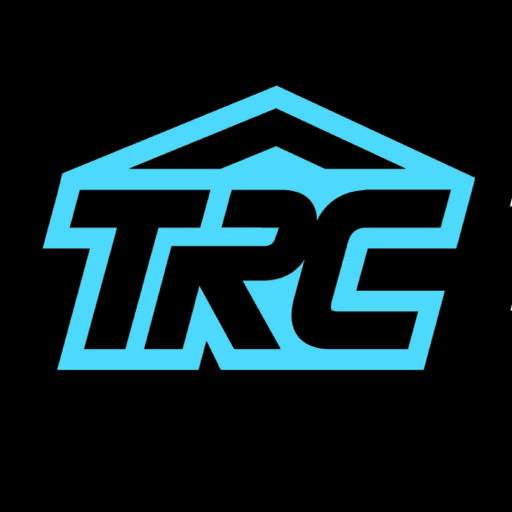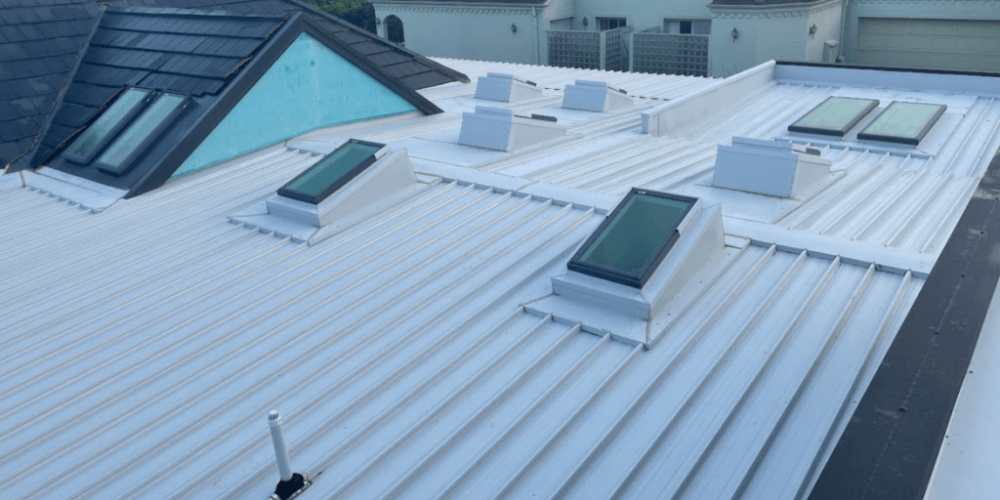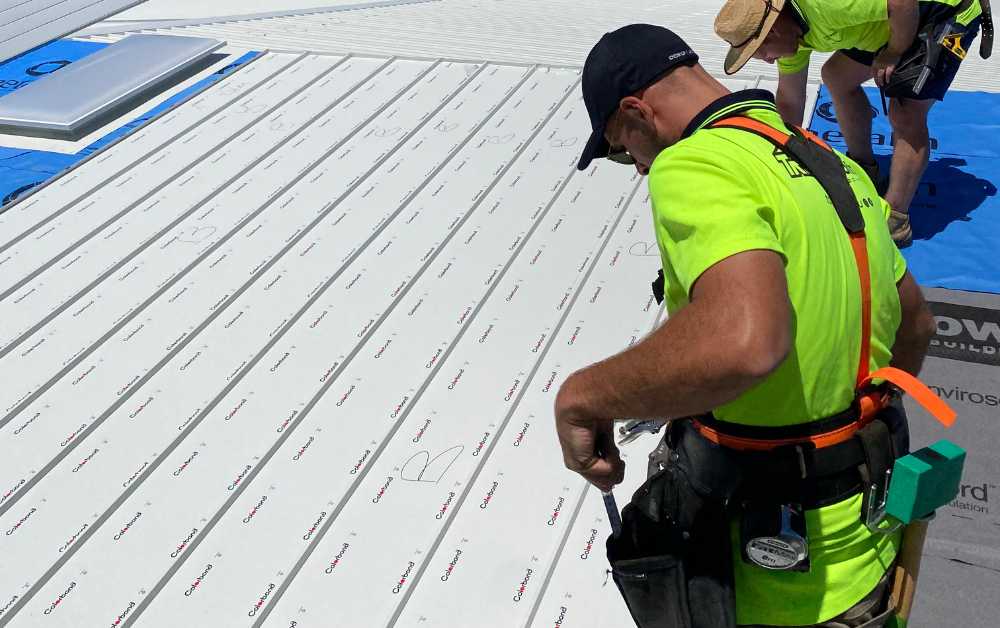Can I Install Solar Panels on Colorbond Roofs?
Imagine harnessing the sun’s power to minimize your energy expenses while contributing to a better, more sustainable future. Solar panels have become popular recently as an environmentally responsible and cost-effective way to generate power. If you have a Colorbond roof, you might wonder: Can I put solar panels on Colorbond roofs?
Colorbond Roofing is well-known for its long-lasting resilience, elegant look, and ability to survive even the most severe weather conditions. It’s a popular choice among both homes and businesses. However, you may be concerned about incorporating solar panels into this type of metal roofing. How do solar panels attach to Colorbond? Are there any specific considerations to keep in mind?
Let’s find out!

Lance Mathews
In This Article
Why Are Colorbond Roofing Perfect For Solare Panel Installation?
Colorbond roofing stands out as an excellent solution for solar panel integration, providing a harmonic balance of structural robustness and functional elegance. Here’s a deeper look at why Colorbond roofing is well-suited to solar panel installations:
Longevity and Durability
Colorbond Roofing is well-known for its outstanding resilience and lifespan. It is constructed of high-quality steel with a unique paint that resists fading, chipping, and corrosion. This implies that the roof can withstand the weight of solar panels while maintaining structural integrity over time.
Weight-Bearing Capacity and Strength
Solar panels may be hefty, especially when used in large arrays to generate much electricity. Colorbond roofing is designed to have a high weight-bearing capability, making it ideal for firmly keeping solar panels in place without drooping or causing structural damage to the roof.
Weather Protection
Colorbond roofing is built to survive harsh weather conditions such as excessive heat, high winds, heavy rain, and even hail. This makes it an excellent choice for holding solar panels constantly exposed to the weather.
Simple to Install
Colorbond roofing is precision-made, and its interlocking construction makes solar panel installation relatively simple and efficient. The homogeneous and uniform surface of Colorbond roofing simplifies connecting solar panel mounting solutions.
Integration and Aesthetics
Colorbond roofing comes in various appealing hues that may be chosen to suit the overall aesthetics of the structure. This is critical for retaining a property’s aesthetic appeal once installed solar panels. Colorbond Roofing’s clean lines and contemporary appearance may help improve the appearance of a solar panel system.
Thermal Efficiency
Colorbond roofing frequently contains thermal insulation features, which can help improve the structure’s overall energy efficiency. This can help maintain a pleasant home atmosphere while maximizing the effectiveness of solar panels.
Mounting System Compatibility
Colorbond roofing is easily adaptable to numerous solar panel installation systems, whether fixed or adjustable. This adaptability enables solar panel installation that is both efficient and secure.
Easy to Maintain
Colorbond roofing requires less maintenance, which means fewer inspections and repairs when solar panels are installed. In the long run, this can save both time and money.

Things To Consider Before Installing Solar Panels on Your Colorbond Roofs
Before putting solar panels on your Colorbond roof, as experienced cladding installers in Melbourne, there are several factors that we consider to guarantee a successful and effective installation.
Here are some of the crucial points we often remember:
Integrity of the Structure
It is critical to ensure the structural integrity of your Colorbond roof for a safe and long-lasting solar panel installation. An engineer’s evaluation will decide if the added weight of the panels would cause structural concerns. This evaluation considers the design and load-bearing capability of your roof’s materials, ensuring that the panels’ weight does not jeopardize your property’s overall stability.
Angle and Orientation
Your solar panels’ orientation and angle directly influence their energy production. South-facing panels collect the most sunshine in the northern hemisphere, whereas north-facing panels are best in the southern hemisphere. The angle at which the panels are positioned influences how much sunshine they get. Proper panel alignment ensures they absorb the most solar energy throughout the day and year, improving energy production.
Shading Analysis
Shading can affect the efficiency of your solar panels dramatically. The projected shadows of adjacent objects, such as trees, chimneys, or adjoining buildings, can generate “hot spots” and reduce energy output. A shading study can assist in identifying potential shade sources at various times of the day and year. Increase the performance of your solar panel system by resolving or mitigating shadowing concerns through smart panel positioning or tree cutting.
Roof Space Availability
The quantity of available roof space determines the size of your solar panel system. Larger arrays provide more energy but require enough clear space on your Colorbond roof. Consider the size of the solar panels, the system’s targeted capacity, and potential future additions. Adequate panel spacing provides for optimum airflow and energy generation.
Roof Warranty and Mounting Systems
The choice of mounting solution is critical when installing solar panels on your Colorbond roof. Different roof slopes necessitate unique mounting systems to ensure panels are stable and properly oriented. Choosing a mounting solution that reduces the requirement for roof penetrations is critical since too many holes might damage the roof’s water tightness and potentially void its guarantee. Colorbond roofing is meant to be protected by non-penetrating or ballasted mounting methods.
Code Compliance and Permits
Solar panel installation necessitates adherence to local construction laws and regulations. There may be unique standards for solar panel installations in your area, including safety, electrical connections, and structural factors. Before installation, obtaining the proper permissions is critical to avoiding legal difficulties and ensuring that your solar panel system satisfies all safety and quality requirements.
Electrical Infrastructure and Inverter Choice:
Your home’s electrical infrastructure must accommodate the electricity provided by the solar panels. You’ll need to determine whether your current electrical system can withstand the added load or whether changes are required. Furthermore, the selection of an inverter system is critical. String inverters, microinverters, and power optimizers have advantages and disadvantages that influence how the system converts and controls solar energy for your house. If you’re interested in energy storage, now is also the time to think about battery integration.
Roof With Solar Panels Maintenance Tips
Maintaining a solar-paneled roof necessitates caring for the solar system and the underlying roof structure. Here are six tips for keeping your roof and solar panels in good condition:
Cleaning Regularly
Clean the solar panels regularly to eliminate dirt, dust, bird droppings, and other debris that might affect their performance. Use a soft brush, a mild hose spray, or specialist solar panel cleaning equipment to prevent harming the panels or the roof.
Inspection of Guttering and Drainage
Keep leaves and debris out of gutters, downspouts, and other drainage systems. Water collection on the roof is prevented by proper drainage, which could seep through the panels or create roof leaks. Water overflow and damage can also result from clogged gutters.
Tree Pruning and Shading
Trim adjacent trees and plants to keep the solar panels from being shaded. Excessive shadowing can reduce energy output while posing extra maintenance issues, such as leaf buildup on panels. Assess and maintain adjacent vegetation regularly to reduce shade.
Professional Inspections
Plan professional inspections of the solar panel installation and the roof structure. Experts can spot problems, including unsecured panels, broken wiring, and probable roof leaks—regular inspections help detect issues and guarantee that the system functions safely and effectively.
Roof Integrity and Sealant Inspection
Examine the sealing and flashing around roof penetrations (where panels are fastened) to verify they are still waterproof. Keep an eye out for symptoms of degradation, cracking, or gaps. Maintain the general integrity of the roof to avoid water penetration and maintain the structure of your home.
Monitoring and Performance Evaluation
Track energy output with the monitoring tools included with your solar system. Sudden decreases in energy output may signal an issue with the panels or the system. Keep track of system performance to fix any concerns as soon as possible.
Bonus Tip: Safety Measures
Prioritize safety when conducting maintenance on solar panels or the roof. Think about hiring specialists if you are not comfortable or knowledgeable about roof work. To maintain a safe maintenance procedure, always follow basic safety measures, wear adequate personal protection equipment, and operate during daylight hours.
Frequently Asked Questions
Solar panels should not damage your Colorbond roof if fitted correctly. Roof penetrations are reduced, and the roof’s integrity is maintained with proper mounting. To avoid problems, it is critical to cooperate with competent installers.
Conduct a shading study to discover probable sources of shade. Trees and plants that throw shadows on your solar panels should be pruned or removed. Panel installation and maintenance can assist in reducing shading-related energy losses.
Reinforcement may be required depending on the state of your roof and its load-bearing capability. An engineer’s evaluation can establish whether any structural improvements are required to sustain the weight of the solar panels properly.
Improper installation, particularly excessive roof penetrations, may jeopardize the manufacturer’s warranty on your Colorbond roof. Select non-penetrating or well-sealed mounting options to guarantee warranty compliance and speak with the roof manufacturer.
Conclusion
So, when considering installing solar panels on your Colorbond roof, you’re making a smart move for your wallet and the planet. It’s like hitting two birds with one stone – lower energy bills and reducing your carbon footprint. But, like with any project, some key things must be remembered.
Make sure your roof can support the weight of the solar panels and that they are positioned to capture as much sunlight as feasible. Trim any trees or items that create shadows on the panels and inspect them regularly for upkeep. Work with specialists to correctly install the panels and secure the appropriate permissions. Solar panels may reduce power costs and boost home value but they must be maintained regularly.
Going solar with your Colorbond roof is a win-win situation. You are helping the environment while receiving the advantages of renewable energy. Remember that a little preparation, upkeep, and expert assistance will make your solar journey enjoyable and rewarding.

